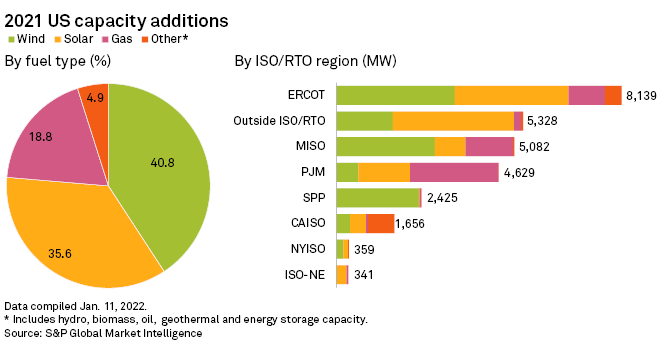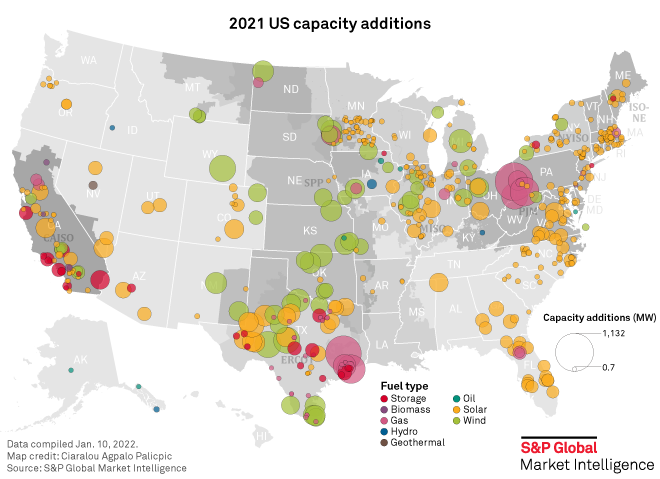The U.S. added 27,959 MW of new generating capacity to the grid in 2021, 12% more than the previous year, according to an S&P Global Market Intelligence analysis.
Meanwhile, 8,556 MW of capacity was retired in 2021, netting an additional 19,403 MW available to the U.S. power grid.
Wind and solar capacity dominated the new additions, accounting for 41% and 36%, respectively. Natural gas-fired capacity, which made up about a quarter of additions in 2020, made up less than a fifth in 2021.

The Electric Reliability Council of Texas Inc. led organized power market regions in new capacity additions. Power plant operators energized 8,139 MW of new generating capacity in the region, equivalent to 29% of the nation's total.
The new generation comes after a major blackout in February 2021, when historically cold weather prompted power plant failures and fossil-fuel supply issues.
Texas policymakers have pledged to keep the lights on this winter, but the new additions will add only moderate reliability benefits to the market: 42% of the new additions were from wind, followed by 40% from solar. Natural gas-fired capacity, which suffered critical failures during the blackout, represented a 13% share of new additions. Energy storage additions were also limited, at 480 MW, but the resource is growing quickly.
For now, Texans will need to mostly rely on updated weatherization rules and the potential of proposed market design changes to handle any additional sharp freezes and summer heat.
The two largest individual plants added to the ERCOT grid included NextEra Energy Resources LLC's 500-MW, 180-turbine White Mesa Wind Project and Algonquin Power & Utilities Corp. subsidiary Liberty Power Group's 492-MW Maverick Creek Wind Project. A number of corporate buyers, including Apple Inc., have contracted for output from White Mesa, while General Mills Inc. is taking a portion of the Maverick Creek project's output.
More than half of the new capacity added in the nation's largest power market, the PJM Interconnection LLC, is natural gas-fired generation. Market incentives and reliability needs for natural gas-fired generators remain very strong in the region, according to industry observers.
Several large plants made up the bulk of new gas-fired additions in the region, including the 1,132-MW South Field Energy plant in Ohio, the 620-MW Hill Top Energy Center in Pennsylvania and the 485-MW Long Ridge Energy Generation Project in Ohio.
The Midcontinent ISO region, stretching from Northern Texas up through the central United States, added more than 5,000 MW of capacity. The additions represented about 18% of capacity additions in the U.S. in 2021, with just over half of that powered by wind. Notably, Entergy Corp. subsidiary Entergy Texas Inc. in January brought online the natural gas-fired Montgomery County Power Station (MCPS) in Texas, supplementing the MISO grid with a total 993 MW of additional capacity from three new units.
Both the MISO market and the neighboring Southwest Power Pool Inc., which added 2,425 MW of nearly all wind capacity, struggled with the same February 2021 freeze as ERCOT, resulting in varying degrees of bulk electric system reliability issues.
MISO's first hybrid solar-plus-storage resource is expected to enter operations in early 2022 after Entergy Arkansas LLC finalizes construction.
Energy storage makes a presence
Citing lower costs and increased renewables, momentum continued in the growth of battery energy storage systems in 2021, roughly doubling with 1,262 MW online, compared to 640 MW in 2020. The California ISO region remains the leading state in energy storage additions, but its lead is dropping quickly. While CAISO remained the front runner with 55% of the total in 2021, the ERCOT region took a 38% share of total new capacity.
The largest battery energy storage system, the 230-MW McCoy Battery Storage Project, came online in May 2021 in California, with the next two largest systems in Texas, namely the 102-MW Gambit Battery Energy Storage Park and the 100-MW North Fork Battery Storage Project.
Outside of ISO and RTO regions, the U.S. added another 5,328 MW in 2021. Of that total, solar accounted for 65%, with wind making up 30%.
The largest project installed outside of power market regions was PacifiCorp's 503-MW TB Flats I & II Wind Project that went into service in July 2021 in Carbon County, Wyo.




